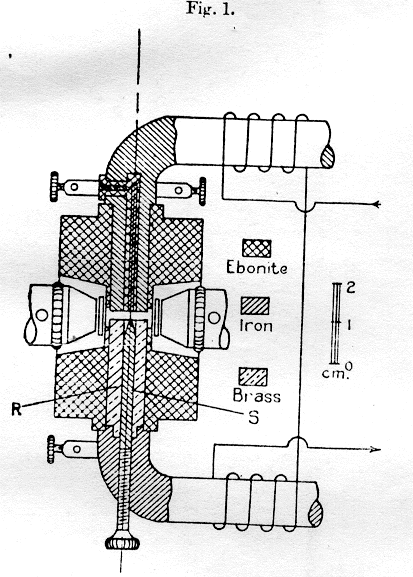http://www.rexresearch.com/ehrenhaf/b1.gif

 http://www.rexresearch.com/ehrenhaf/ehrenhaf.htm
http://www.rexresearch.com/ehrenhaf/ehrenhaf.htmfree this one had theorized,
, Dr Ehrenhaft concludes that these are electrically charged particles --- ordinary ions--- rotating about a magnetic current. This would be an exact counterpart of the classical conception that magnetism rotates about a current-carrying electric conductor.
What gives the utmost significance to the reported feat of breaking up water with a magnet is the fresh evidence it offers for the existence of "magnetic current", or a flow of magnetically charged particles, which has been suspected by noted pioneers and which Dr Ehrenhaft now maintains he has proved. Confirmation of this amazing discovery would point to a possible future rival of electric current, perhaps capable of being harnesses in undreamed-of ways.
Needless to say, the scientific world will require a whole lot of convincing, since Dr Ehrenhaft’s conclusions flatly contradict long-established beliefs. As every schoolboy is taught, a magnet has a north pole and a south pole. Break it in two with a hammer, and each piece will have a north pole and south pole of its own. No law forbids you to imagine a magnet with only one pole, and the idea comes in handy in certain electrical and radio calculations. But as for actual fact, you cannot have one pole without the other, an experimenter named Peter Peregrinus believed; he demonstrated it to his satisfaction, using a lodestone, in the year 1269, and prevailing opinion has backed him up ever since. As we kiow now, the lodestone that he floated on a platform in water simply turned until its north pole faced the south magnetic pole of the earth, and vice versa. It showed no observable excess of north or of south magnetism --- and hence the conclusion that the two are always equal.
Needless to say, the scientific world will require a whole lot of convincing, since Dr Ehrenhaft’s conclusions flatly contradict long-established beliefs. As every schoolboy is taught, a magnet has a north pole and a south pole. Break it in two with a hammer, and each piece will have a north pole and south pole of its own. No law forbids you to imagine a magnet with only one pole, and the idea comes in handy in certain electrical and radio calculations. But as for actual fact, you cannot have one pole without the other, an experimenter named Peter Peregrinus believed; he demonstrated it to his satisfaction, using a lodestone, in the year 1269, and prevailing opinion has backed him up ever since. As we kiow now, the lodestone that he floated on a platform in water simply turned until its north pole faced the south magnetic pole of the earth, and vice versa. It showed no observable excess of north or of south magnetism --- and hence the conclusion that the two are always equal.
But would the dictum of no separate magnetic poles still hold true in a far more delicate test --- say, if you substituted microscopic particles of iron or other magnetic metals, as tiny as particles of smoke, for the massive chunk of rock that Peregrinus used? Dr Ehrenhaft has tried it. In an air gap between the north and south poles of a magnet, he sets up what he calls a homogenous magnetic field, that is, with the lines of force absolutely parallel. In this field, he finds, the meal particles move toward the north or south pole, reversing their direction according to the direction of the magnetic field. In the particles, he concludes, there must be an excess of N or S magnetic charge. Expanding the terminology of Faraday, he calls the particles magnetic ions. They are the single magnetic poles shown at the lower right of the drawing. Instead of bearing plus or minus electric charges, as familiar ions do, they carry N or S magnetic charges.
Now, just as traveling electric ions form an electric current, why shouldn’t traveling magnetic ions form a magnetic current? See for yourself another of Dr Ehrenhaft’s startling experiments, and draw your own conclusions.
This time the heart of the apparatus will be a small glass cell, fitted as before with pole pieces of pure iron that dip into water containing one percent of sulfuric acid. An electromagnet, turned on or off at will, energizes the poles. From a projector, a powerful beam of light converges upon the narrow gap between the pole pieces, and a low-power microscope, mounted horizontally, reveals that happens there. Adding a camera provides a permanent record.


 the circle must be at the center. why to magnetize blocks. the picture on the mettle door.
the circle must be at the center. why to magnetize blocks. the picture on the mettle door.



